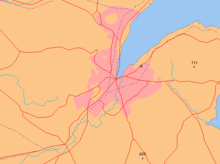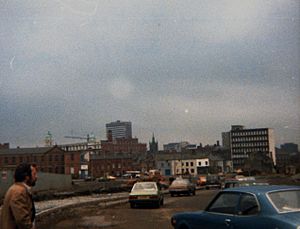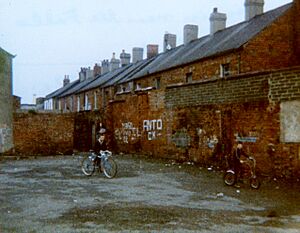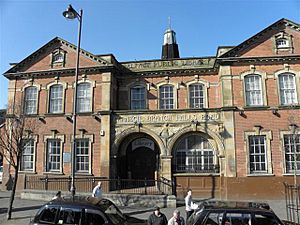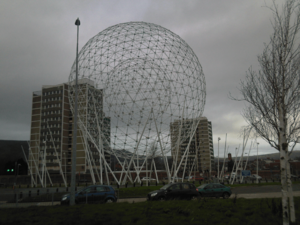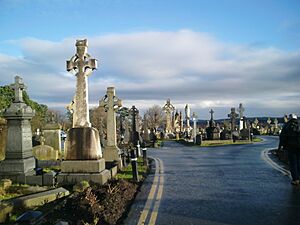Falls Road, Belfast facts for kids
| Bóthar na bhFál (Irish) | |
| Irish: Bóthar na bhFál Ulster-Scots: Faas Raa | |
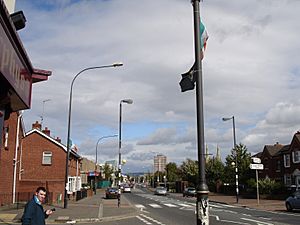
Falls Road looking towards Divis flats and the city centre
|
|
| Maintained by | Belfast City Council |
|---|---|
| Length | 1,600 m (5,200 ft) |
| Location | Belfast, Northern Ireland |
| Postal code | BT12 |
| Coordinates | 54°35′36″N 5°57′30″W / 54.59347°N 5.95823°W |
| Northeast end | Divis Street |
| Southwest end | Andersonstown Road |
| Other | |
| Known for | Numerous murals, Irish republican community |
The Falls Road (from Irish túath na bhFál, meaning 'territory of the enclosures') is the main road through West Belfast, Northern Ireland, running from Divis Street in Belfast City Centre to Andersonstown in the suburbs. The name has been synonymous for at least a century and a half with the Catholic community in the city. The road is usually referred to as the Falls Road, rather than as Falls Road. It is known in Irish as the Bóthar na bhFál and as the Faas Raa in Ulster-Scots.
Contents
Location
The Falls Road forms the first three miles of the A501 which starts in Belfast city centre and runs southwest through the city forking just after the Falls Park into the B102 which continues for a short distance to Andersonstown. The A501 continues as the Glen Road. The area is composed largely of residential housing, with more public sector housing in the lower sections of the road. There are many small shops lining the road as well as schools, churches, hospitals and leisure facilities. Employment in the area was originally dominated by the large linen mills but these have mostly closed. Today, local employment is in the service sector, health and education with additional employment in other parts of the city.
The Falls Road district can be roughly divided into three sections. The Lower Falls which includes Divis Street starts near the city centre and continues to the junction with the Grosvenor Road. The middle Falls district centres on Beechmount. The Upper Falls starts about the Donegall Road and continues into Andersonstown.
The short stretch of the road from the city centre to the start of Divis Street at Millfield is known as Castle Street after the former Belfast Castle which was built nearby by the Normans in the 12th century. Castle Street begins at the junction with Royal Avenue and Donegall Place, the main shopping district of Belfast. Two large buildings flank either side of the entrance to the street. On one side is the Bank Buildings and on the other is the former home of the Anderson & McAuley department store.
Near the start of Castle Street is Chapel Lane on which St. Mary's Church is situated. This is the oldest Catholic church in Belfast and dates from 1784. Nearby on Bank Street is located the historic Kelly's Cellars bar which dates from 1720. Opposite was located St. Mary's Hall, a popular social venue which was constructed in 1875 but demolished in 1990. Bank Street begins at Royal Avenue. The ornate building at its entrance was the former home of the Provincial Bank of Ireland which was erected in 1869. When it closed in 1989, the building was occupied until 2021 by a Tesco store. It was then refurbished as a social facility by Belfast City Council.
History
The Falls Road derives its name from the Irish túath na bhFál, an Irish petty kingdom whose name means "territory of the enclosures". These enclosures resulted from the Plantation of Ulster which occurred from the seventeenth century. This territory was roughly the same as that of the ecclesiastical parish of the Shankill, which spanned a large portion of modern-day Belfast.
The Falls Road itself was originally a country lane leading from the city centre but a largely Catholic population—refugees from a rural poverty that been intensified by Belfast's mechanisation of what had been a cottage textile industry and, in the 1840s, by famine—was drawn to the area by the prospects for female and child employment in new linen mills. All of these mills have now closed or have been repurposed. This original area, which was centred on the junction of modern-day Millfield and College Avenue on what is now Divis Street, was known as Falls and lent its name to the road. which had previously been called The Pound. The housing in the area developed in the 19th century and was organised in narrow streets of small terraced housing. The Westlink linking the M1 and M2 motorways now cuts through this area.
Lower Falls
This section of the road stretches from the junction of Castle Street and Millfield to the Grosvenor Road/Springfield Road intersection. The lower part of the road is named Divis Street after the Divis mountain which overlooks much of West Belfast. The Falls Road proper begins at the junction with Northumberland Street and Albert Street. The area to the south of Divis Street/Lower Falls Road was considered the heart of the district and was initially composed of rows of small terraced houses which were constructed in the mid to late nineteenth century to house mill workers and their families. The area is detailed in the 1931 Ordnance Survey map of the area. Shortly after Millfield, the road crosses over the Westlink (A12) which links three motorways - the M1 to the southwest of the city, the M2 to the north and the M3 to the east. Running alongside the Westlink is Townsend Street which originally marked the end of Belfast. Townsend Street links Divis Street with Peter's Hill at the bottom of the Shankill Road.
Housing
The housing in the area developed in the 19th century and was organised in narrow streets of small terraced housing. Many of the streets were named after local mill owners. Alexander Street West was named after John Alexander who was a local mill owner. He also named Milford Street after Milford Mills, County Carlow where he had a house. Ardmoulin Street was named after Ardmoulin House, the residence of John Chartres of Falls Flax and Weaving Company. Craig Street was called after the Craig family who owned the New Northern Mill at the corner of Northumberland Street.
By the 1960s the buildings in the area had decayed considerably and the Belfast Corporation introduced a major development plan which involved wholescale demolition of much of the area. Many of the old street names were retained in the new housing development. In the Divis Street area, the housing was replaced with the Divis Flats complex which consisted of twelve blocks of flats built on top of the historic district formerly known as the Pound Loney. The high point of this redevelopment was Divis Tower. Because of its rapid deterioration, the whole complex, except for Divis Tower, was demolished thirty years later and replaced with blocks of terraced housing.
Past Albert Street, more mills were built on the northern side and more streets of small terraced houses on the southern side. The old streets were named after characters and events in the Crimean War (1853–1856) which was occurring at that time. These include Raglan Street (named after Lord Raglan, commander of British forces in the Crimean War), Garnet Street (after Garnet Wolseley, 1st Viscount Wolseley), Alma Street (after the Battle of Alma), Balaklava Street (after the Battle of Balaklava), Inkerman Street (after the Battle of Inkerman), Sevastopol Street (after the Siege of Sevastopol), Plevna Street (after the Siege of Plevna), and Varna Street (after the Siege of Varna). There were also streets named after Balkan places such as Bosnia Street, Balkan Street, Roumania Street and Servia Street, as well as Omar Street (possibly after Omar Pasha). Other streets were named after contemporary political and royal figures such as Peel Street (after Robert Peel) and Albert Street (named after Prince Albert).
These street names are recalled in the collection of poetry The Irish for No by Ciaran Carson. In one of the poems entitled "The Exiles' Club", Carson imagines a group of Belfast exiles:
- After years they have reconstructed the whole of the Falls Road, and now
- Are working on the back streets: Lemon, Peel and Omar, Balaclava, Alma.
All of these houses have now been demolished and replaced with modern terraced houses.
At the foot of Divis Street is located the Morning Star House. This is a hostel which provides temporary accommodation for homeless people. It is run by the Legion of Mary and was originally located at the corner of Percy Street. Additional accommodation for homeless people is provided nearby by First Housing at Ardmoulin Mews, off Ardmoulin Street.
Schools
At the foot of Divis Street is located the Millfield campus of Belfast Metropolitan College, the largest further and higher education college in Northern Ireland. Nearby was located the original St. Mary's Christian Brothers' Grammar School. In the 1960s, this school transferred to a greenfield site on the Glen Road in the upper Falls. The original school building is now the home of the Edmund Rice Schools Trust. Opposite is St. Mary's Primary School. Nearby is the location of the Árd Scoil which was historically the centre for Irish language and culture in the area. Just past it was located the Hastings Street RUC station.
There are currently two other primary schools in the Lower Falls district. These are St. Peter's on Ross Road and St. Joseph's on Slate Street. In addition, there is the Irish language Gaelscoil an Lonnáin which occupies the site of St Finian's Primary School at the top end of Leeson Street. St Finian's School and the nearby St. Gall's Primary School closed in the late twentieth century due to declining student numbers. These schools were run by the De La Salle Christian Brothers. The name of the latter school survives in the name of St. Galls' Avenue. St Comgall's Public Elementary School, in Divis Street, opened in 1932 but closed in 1988. It has been transformed into a community hub for a range of community and business activities. The centre is named Ionad (Centre) Eileen Howell after a local community activist. St. Brendan's Primary School on nearby Milford Street closed in the 1960s but for two years housed some pupils from St. Mary's Christian Brothers' Grammar School which at that time had exceeded its capacity in its Barrack Street premises.
The Dunlewey Centre is located near Gaelscoil an Lonnáin. The building was originally the home of the Bon Secours Sisters and also housed St. Vincent's Primary School for Girls. It is a now the home of a community education centre. Dunlewey Street on which it is located is named after the residence of a local mill owner, William Ross, who owned a house in Dunlewey, County Donegal. The nearby Ross Road is also named after William Ross.
Churches
The churches in the Lower Falls district reflect the changing demographics of the area. There are three Catholic churches in the area. The oldest is St. Mary's Church which opened in 1784 (see above). St Peter's Cathedral is located just off Albert Street. This was originally a parish church built for the expanding Catholic population in the area and opened in 1866. It was designed by Fr Jeremiah Ryan McAulay, who had trained as an architect before he became a priest, and built on a site donated by a local baker, Bernard Hughes. It became the cathedral church for the Roman Catholic Diocese of Down and Connor and the episcopal seat of the Bishop of Down and Connor in 1986. It is home to St Peter's Schola Cantorum (Choir). Clonard monastery, the home of the Redemptorist religious order, is located near the junction with Springfield Road. The church formally opened in 1911 replacing a small church which opened in 1897. Father Alec Reid who played an important role in the Northern Ireland peace process was based here.
There were/are seven Protestant churches which were/are largely located on the edges of the area and their congregations were/are mostly drawn from neighbouring districts. All but one of the older churches have been closed, repurposed or demolished since the onset of the Troubles and the establishment of the peace lines. There were three Church of Ireland churches. St. Luke's Church (1863-2006) on Northumberland Street, was the Church of Ireland church for the Lower Falls. When it closed its congregation amalgamated with St. Stephen's Church in Millfield at the foot of Divis Street. This church which opened in 1856 was designed by Sir Thomas Drew who also designed St. Anne's Cathedral and many other churches. St Philips Church (Drew Memorial) opened on the Grosvenor Road in 1870. It was named after the fiery preacher Rev. Dr. Thomas Drew who hailed from Limerick and became a very influential clergyman when he moved to Belfast. It closed in 1994 and the church congregation merged with that of St. Simon's Church on the Donegall Road. A war memorial from the church is preserved in the Somme Museum, Newtownards. The church was sold to Dwyer's Gaelic Athletic Club who built their clubrooms on the site.
There were two Presbyterian churches. The largest was located on the other side of the peace wall dividing Townsend Street which links Divis Street with Peter's Hill, the lower Shankill Road. It opened in 1878 and formally closed in 2022 when it was taken over as a rehearsal space by the Ulster Orchestra. Nearby was located the Soho Foundry established by Robert Shipboy MacAdam in 1846. It is now an enterprise centre. There was also a Presbyterian church in Albert Street (1852-1972) where one of the ministers was the Rev. Henry Montgomery who helped establish the Shankill Road Mission in 1896. The Maureen Sheehan Centre is now located on the site of the church. The centre is named after a local community nurse who was killed in a nearby car accident. Four sculptures from the church are featured in the facade of the centre.
There was also a Methodist church in Divis Street (1850-1966). This church was designed by Charles Lanyon and was the original home of the Falls Road Orange Lodge. Nearby was the Hungarian Flour Mill owned by Bernard Hughes. The mill burned down in a fire in 1966.
A recent addition is the New Life City Church which is located on Northumberland Street on the peace line marking the separation of the Falls Road and the Shankill Road. It is an Elim Pentecostal Church.
Commercial facilities
The Lower Falls area previously had many linen mills. These have either been demolished or converted for other purposes. The Twin Spires Complex has replaced the demolished massive mill of the New Northern Spinning and Weaving Company (Craig's Mill) which was located at the corner of Northumberland Street. The new complex consists of shops, offices and small industrial units. On the corner of Conway Street was located Greeves' Mill (original owner Thomas Greeves of Strandtown, Belfast) and also the Conway Mill (original owner James Kennedy of nearby Clonard). Originally a flax spinning mill, it now houses a community enterprise of small businesses, art studios, retail space and education floor. It also houses the Irish Republican History Museum. Finally, Ross's Mill was located on Clonard Street with an entrance at the top of Sevastopol Street. It has been demolished and replaced by housing but its name survives in the street name Ross Mill Avenue.
There are still two large flour mills located in the lower Falls district. Near the bottom of Divis Street is located Neill's Flour Mill which is entered via College Square North. This mill was originally a small stone mill but was taken over by James Neill in 1867 who converted it into a roller mill in 1880. This mill grew in size and in the 1960s it became part of Allied Mills which in turn became part of Associated British Foods. The original mill was then demolished and rebuilt in 1986–7. Between Northumberland Street and Percy Street is located Andrews Flour Mill. The mill was originally developed in 1895 by the Andrews family from Comber, County Down. J. M. Andrews was the second Prime Minister of Northern Ireland (1940-1943). Northumberland Street and Percy Street were named after Hugh Percy, 3rd Duke of Northumberland who was the Lord Lieutenant of Ireland 1829–1830. Percy Street was badly damaged in the Belfast Blitz (1941) and 30 people were killed when a bomb hit a shelter. In August 1969, Percy Street and the neighbouring Dover Street were the location for major disturbance when a large crowd of Loyalists from the Shankill Road end attempted to invade Divis Street. Houses in the street were attacked and the residents fled (see 1969 Northern Ireland riots). These mills recruited workers from both the Falls and Shankill Roads.
Leisure facilities
The Falls Leisure Centre is located in the lower Falls district. It currently offers a range of leisure facilities including a swimming pool, sauna and steam rooms, a gym, and a badminton court. It was originally the location of the Falls Public Baths where local residents could avail of washing and swimming facilities. On 16 April 1941, it was the site of a temporary morgue following the Belfast Blitz. This is described in the novel The Emperor of Ice-Cream by the novelist Brian Moore.
One of three Carnegie libraries built in Belfast is situated in the lower Falls Road. It opened on 1 January 1908 and is the last Carnegie library in Belfast still functioning as a library. Opposite was located the Clonard Picture House which closed in 1966. The Diamond Picture House at the corner of Cupar Street closed in 1959. The Arcadian Cinema on Albert Street opened in 1912 but closed in 1960.
At the junction with Grosvenor Road is located Dunville Park which was first opened in 1893. It was funded by Robert G Dunville, the owner of the nearby Dunville & Co whiskey distillery. who also funded the large fountain at the centre of the park which was designed by the English sculptor Arthur Ernest Pearce. Sorella Street at the foot of the park is named after the Sorella Trust which was established by Robert's uncle William Dunville who named the trust after his sister (sorella in Italian) Sarah. The park has recently been refurbished and includes a football pitch. Nearby are located the clubrooms of Davitt's GAC and Dwyer's GAC.
A strong working class community, the Lower Falls has a history of storytelling, music and song which was often enjoyed in the many public houses in the area. These included such establishments as the Old House (famous for its folk music sessions), McGeown's, the West End Bar (owned by Peter and Molly Murray and famous for its weekend sing-songs), the Laurel Leaf, the Centre Half and Haughey's. Gerry Conlon, who grew up in Peel Street, recalled in his autobiography Proved Innocent how he could see several pubs just a few yards from his front door: I'd watch the men off to the pubs. There were three pubs, Paddy Gilmartin's which was called the Laurel Leaf, Peter Murray's [the West End Bar] directly opposite, or further down on the right-hand side was Charlie Gormley's, across from Finnegan's the butcher shop. The Centre Half Bar which was located at the corner of Panton Street and the Falls Road was named by the licensee Mickey Hamill who played for both Belfast Celtic and Glasgow Celtic as well as Manchester United and Manchester City. He captained the Ireland team to their first Home International championship win in 1914. The Spanish Rooms bar, in lower Divis Street, was famed for selling scrumpy, especially to young men on their way to a dance. In the early 1970s it was the largest seller of cider in Britain and Ireland. Most of these bars were demolished as part of the redevelopment of the area which occurred in the 1970s and 1980s.
Near the foot of Divis Street is located the offices of Raidió Fáilte, an Irish language community radio station. It is housed in a purpose-built facility. Nearby, on the Cullingtree Road, is located the Frank Gillen Centre which offers a range of community services. Closer to the city centre, in College Court, off Castle Street, was located the Astor Ballroom which was a very popular dance venue in the 1960s and where such famous bands as Thin Lizzy and Them performed.
Murals
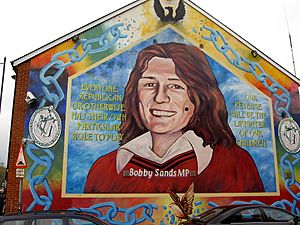
On some walls along the main road have been painted large murals. These are representations of local and national political issues and figures. One of the most famous is the large mural of Bobby Sands on the side wall of the Sinn Féin's offices at the corner of Sevastopol Street. It bears the quotation from his writings: our revenge will be the laughter of our children. Further down the road on the corner of Northumberland Street is a series of murals which has come to be called the International or Solidarity Wall. This is a series of images of international figures who have been involved in various liberation struggles. These murals have become a popular attraction for visiting tourists. The murals are frequently updated to reflect local support for certain individuals and groups (e.g. NHS staff). In 2023, a panel on the wall calling for an immediate ceasefire in Gaza was unveiled. There are many other murals on nearby gable walls frequently exhorting peace and reconciliation between communities. One in Bread Street, off Albert Street, has a quotation from Audre Lorde: It is not our differences that divide us. It is our inability to recognize, accept and celebrate those differences.
Middle Falls
This section of the road centres on the Beechmount district and stretches from the intersection with the Grosvenor Road/Springfield Road to the Whiterock Road. The district takes its name from Beechmount House which was located at the top of a nearby hill surrounded by beech trees. It was the former home of Eliza and Isabella Riddel. It is now the site of an Irish Language school.
The Whiterock Road leads to the Ballymurphy and to Turf Lodge districts. It also leads to the Black Mountain which forms part of the range of hills overlooking Belfast. Across the Falls Road from the Whiterock Road is the Donegall Road. This road leads down to the junction with Broadway and Westlink – M1 motorway and then on down to Shaftesbury Square in the city centre. At the junction with Westlink is located the large public sculpture formally called RISE but informally known as the balls on the Falls.
Through the area flowed the Clowney Water or River (Irish Abhainn na Cluana - River of the meadow) which is a tributary of the larger Blackstaff River. Both have largely been covered over and piped in.
Hospitals
There are several large hospitals in the area including the Royal Victoria Hospital, the Royal Jubilee Maternity Service, the Royal Belfast Hospital for Sick Children (Children's Hospital), and the Royal Dental Hospital. These four linked hospitals make up Northern Ireland's biggest hospitals complex. The Royal Victoria Hospital treats over 80,000 people as inpatients and 350,000 people as outpatients every year. The complex is a major training site for medical, dental, nursing and other health students from Queen's University Belfast. The original hospital opened in 1797 and moved to its present site in 1903. The hospital was designed by Henman and Cooper of Birmingham in 1899, completed in 1906. It was claimed to be the first air-conditioned public building in the world.
Opposite the Children's Hospital is Mulholland Terrace, a row of terraced houses which were built in the nineteenth century by David Mulholland. He also owned several bars in the area.
Schools
There are several educational institutions in the district. At the primary level, St. Paul's Primary School is located in the Beechmount area. There are also two Irish language primary schools. These are Gaelscoil na bhFal and Bunscoil an tSléibhe Dhuibh.
At the senior level, there is St Dominic's Grammar School for Girls. Beside it was located St. Catherine's Primary School which was also run by the Dominican nuns but closed in 2005. At the rear was located St Rose's High School in the Beechmount district which in 2019 was amalgamated with the Christian Brothers School, Glen Road and Corpus Christi College to form All Saints College / Coláiste na Naomh Uile.
There were several boys secondary schools in the area which have gone through a process of merging over the past forty years. St. Thomas's Boys Secondary School on the Whiterock Road opened in 1957. St. Peter's Boys Secondary School on Brittons Parade opened in the 1960s. In 1988, both of these schools amalgamated with Gort na Móna Secondary School to become Corpus Christi College which in turn merged (see above). St. Thomas's had a strong literary heritage. For a period, its headteacher was the writer Michael McLaverty. In addition, Seamus Heaney taught here for a while in the 1960s. He references the area in one of his poems:
- Is there life before death? That's chalked up
- In Ballymurphy. Competence with pain,
- Coherent miseries, a bite and a sup,
- We hug our little destiny again.
Brendan Hamill, another writer, who attended the school in the 1960s recalled later: While on teaching practice, Seamus Heaney came to St Thomas' about October that year (1962). I remember him, his voice grave and resonant, his big, brown shoes, reading from Carrickfergus by Louis MacNeice. He was an enormously decent man with extraordinary antennae. Joe Graham, the writer and historian, was also a student at the school when McLaverty was the headteacher. For several years, after the school closed, this building was used by Belfast Metropolitan College for further education courses. After the new Springvale campus of the college was opened the building was demolished.
Coláiste Feirste is an Irish language secondary school which is situated near Beechmount, in the former home of the Riddel family. Mo Chara from the Belfast-based hip hop trio Kneecap attended this school.
At the higher education level, there is St Mary's University College which is part of Queen's University Belfast. This was established in 1909 as St Mary's Training College to train women as teachers. It amalgamated with St Joseph's Training College (for male trainee teachers) in 1985. Besides teacher training it now offers a range of degree courses. The college has a substantial programme of community engagement playing host to many local events including many organised by Féile an Phobail.
Churches
St Paul's Church is located opposite the hospitals on the corner of Cavendish Street. It was built as a chapel of ease to St Peter's Cathedral and celebrated its first Mass in July 1887. St.Paul's was raised from "a district of St Peters" to the status of a parish in 1905. Broadway Presbyterian Church opened in 1891 but closed in 1982. It has since been repurposed as an Irish language arts and culture centre (see below).
Recreation and culture
Near Beechmount is located Willowbank Park which has a number of playing fields. It is located on the site of the Willowbank Huts which in the late nineteenth century housed a small British Army barracks. When the huts were vacated they were used by various groups including Fianna Éireann. Corrigan Park which is a facility for Gaelic games is located on the Whiterock Road. A nearby smaller facility for various sporting activities is McCrory Park. It was named after Cardinal Joseph MacRory who was Bishop of Down and Connor and then Primate of All Ireland in the early part of the twentieth century. During the 1970s it was occupied by the British Army who called it Fort Pegasus. The playing fields of the Davitt's GAC are located in Beechmount. The Whiterock Leisure Centre is located off the upper Whiterock Road. It has a community garden and allotment site. Developments include a playground and multi-use games area. At the foot of St. James's Road and sandwiched between Rodney Parade and the M1 motorway is located the St. James's Community Farm. This was an abandoned piece of land that was transformed by local residents into a community farm providing facilities for around 50 animals and various gardening initiatives.
Historically, there has been a continuing interest in the Irish language and culture in the area. In 1936 the Cluain Árd centre was established in the Beechmount area and became a centre for Irish language enthusiasts. In the 1960s, there was a resurgence of interest in the Irish language reflected in the development of the Shaw's Road Gaeltacht in Andersonstown. Since then, interest has grown, with the approval by Belfast City Council of a Gaeltacht Quarter around the Falls Road in 2002. The Cultúrlann McAdam Ó Fiaich, known colloquially as the Cultúrlann, is an Irish language and arts centre based in the middle Falls area which opened in 1991. It was originally the home of Broadway Presbyterian church. The centre also houses the Irish language bookshop An Ceathrú Póilí. The Féile an Phobail, an annual festival of Irish culture, which was established in 1988 provides a showcase for Irish culture. Nearby, at the corner with Broadway, is the new Áras na bhFál, the home of Iontaobhas na Gaelscolaíochta - the Trust Fund for Irish-Medium Education.
The Áras Uí Chonghaile/James Connolly Visitor Centre is located near the top of the Donegall Road. This centre is dedicated to the life and work of James Connolly who lived nearby for a period in the early years of the twentieth century.
There are several large bars in the middle Falls area. These include the Beehive and the Red Devil - An Diabhal Dearg, at the top of Broadway, and the Rock Bar at the top of the Donegall Road. The Rock Bar is described as the oldest bar on the Falls Road. It was subjected to a loyalist attack with an RPG rocket in 1994 but survived and no customers were injured.
The Broadway Cinema which was situated near Beechmount was the largest of Belfast's suburban cinemas when it opened in 1936. It closed in 1972 after a bombing. Nearby is the Falls Women's Centre/Ionad Mhná na bhFál which was established in 1982.
On the Donegall Road, is the former site of Celtic Park. This was originally a football stadium and the home of Belfast Celtic F.C. It was also the first greyhound racing track to open in Ireland. The stadium closed in 1983 and is now the site of a shopping centre.
Upper Falls
This section stretches from the Whiterock Road to the Andersonstown Road. As its name implies, the Andersonstown Road leads to the Andersonstown district and the on out of the city. At the junction with the Glen Road was located the Andersonstown RUC station which was the most attacked police station in Northern Ireland. It was closed and demolished in 2005. The Glen Road runs for almost three miles passing the junction with Monagh By Pass/Kennedy Way, then Shaw's Road and Suffolk Road until it changes name to Colinglen Road. For much of the route in forms the northern boundary of Andersonstown and then Lenadoon.
Schools
St. Louise's Comprehensive College which was one of the largest girls schools in Europe with over 2,000 pupils is located in this area. In 2019, it was decided to admit boys and to reduce the overall student numbers to 1500. Nearby is located St. Kevin's Primary School which was established in 1933. There is also the St. Maria Goretti Nursery School on the Whiterock Road.
Churches
The St. John's RC Church is located near the foot of the Whiterock Road. It was originally established in 1928 as the population of the area increased.
St. Matthias's Church is located on the Glen Road not far from Milltown Cemetery. On the site, the original Church of Ireland church was erected in 1892. It formally closed in 1969 but was taken over by the catholic parish of St Teresa of Ávila, the main church of which is located further up the Glen Road. The building reopened as a catholic church under the same name in 1970. A new catholic church opened on the site in 2004 and the old tin church, which is listed, is in a state of disrepair.
Recreation
In the Upper Falls area is located the Falls Park which was established in 1873. The park has many mature trees, flower beds, horticultural displays and grassland areas. The park contains playing fields for Gaelic games and soccer. It has a 3G pitch, a bowling green and other facilities. Developments include an outdoor gym, a dedicated youth area suitable for a range of uses and a refurbished play park with modern play equipment. In 1924, an outdoor swimming pool, known locally as The Cooler, was added to the park. The pool closed in 1979 for public health reasons. The Féile an Phobail has its closing concert here each year.
Opposite the Falls Park, on Milltown Row, are located the facilities of St. Gall's GAC. Further up the Falls Road is located The Felons, a large social club and restaurant. It is located on the site of a former Methodist meeting house.
Cemeteries
In the late 19th century, with the rapid increase in the city population, there was an increasing need for cemeteries. At that time, the Upper Falls was a rural area and the city council and the Catholic Church decided to buy large spaces in the area to create cemeteries. The Belfast City Cemetery which is located at the bottom of the Whiterock Road, is a municipal cemetery maintained by the Belfast City Council and is one of the largest burial sites in the city. It opened in 1869. At the junction with the Glen Road, is located Milltown Cemetery, maintained by the Catholic Church, which opened in the same year.
At the bottom of Milltown Cemetery is the Bog Meadows which leads onto the M1 motorway. This large wild-life preserve is home to a wide variety of wild flowers, birds and butterflies. Some cattle also graze on the site. It is owned and managed by the Friends of the Bog Meadows and the Ulster Wildlife Trust.
Transport
Originally there was a tram service providing public transport on the Falls Road. This was introduced in the late 19th century and replaced by trolleybuses in 1938. There were three routes along the road: 11 for Falls Road-Whiterock Road, 12 for Falls Road-Andersonstown Road and 13 for Falls Road-Glen Road. The 77 route from the Gasworks to the Waterworks ran via Albert Street/Northumberland Street and cut across the Falls Road and the Shankill Road. The trolleybuses were replaced by diesel buses in the 1960s. With the outbreak of the troubles, the bus service was withdrawn. The gap in public transport was replaced by black taxis. Since the troubles ended, the public bus service has been re-introduced and expanded. Metro, a division of Translink now operates the bus service. The Falls Road is designated one of the quality bus corridors (QBCs) within the city with a variety of different routes.
In 2018, the Glider bus service was introduced. It provides a service from Poleglass via the Falls Road-City Centre and Newtownards Road to Dundonald. It was the first cross-city bus service.
Street names
Following a decision of Belfast City Council in 2021, many of the streets in the area now have bilingual (English-Irish) signs. Guidance on the wording of these signs is taken from the Northern Ireland Place Names Project. Examples are Ardmoulin Street-Sráid Ard an Mhuilinn, Beechmount Avenue-Ascaill Ard na bhFeá.
The Troubles
In the late 1960s, many Catholics from across Northern Ireland began to campaign, many with Northern Ireland Civil Rights Association (NICRA), against discrimination in housing and jobs, under the banner of a civil rights campaign, in conscious imitation of the philosophy of, and tactics used by, the American Civil Rights Movement. Northern Ireland was part of the UK but the voting criteria were different to England, Scotland and Wales where a person could vote as soon as they became 18 years old. In Northern Ireland an 18 year old could only vote if they were the named owner or named renter of a house. Most of the Catholic houses had three generations living in the same dwelling (because of housing discrimination) so only the mother and father could vote. Furthermore, business owners (depending on the size of the company) were entitled to three to six votes unlike anywhere else in the United Kingdom.
Many Unionists saw NICRA as an Irish republican Trojan horse, designed to destabilize Northern Ireland, and force unionists into a united Ireland. Several streets around the Falls Road were burnt out by armed 'B' Specials (Police Reserve) and loyalists in August 1969, with the murder of six Catholics on the first night marking the start of 'The Troubles. In response to the worsening situation, the British Government deployed the British Army on the Falls Road to protect the Catholics from further attacks. The troops were initially welcomed by all the Falls residents to protect them, but heavy-handed tactics by the mostly British-born members of the Army who did not know, care or understand the situation would estrange most Catholics and nationalists.
From 3–5 July 1970, the road was the scene of what became known as the Falls Curfew. 3,000 British troops carried out an operation to search the area for hidden weapon caches, sealing off the streets around the Falls Road. Local youths attacked the troops, who responded by firing 1,600 canisters of CS gas to disperse the crowds. The operation was also opposed by the Official IRA (OIRA), with OIRA gunmen engaging British troops in multiple gun battles across the area. Over the course of the operation, four Catholic civilians were killed by the Army, which recovered ninety rifles. The operation was widely regarded as the end of the British Army's "honeymoon" period with the nationalist community in Belfast.
During the Troubles there were repeated sectarian attacks by loyalists on residents of the Falls Road. These attacks increased during the 1969 Northern Ireland riots when whole streets in the Falls Road area were destroyed by loyalists from the Shankill Road area. Loyalists paramilitaries killed many local residents. Temporary barricades were constructed to provide residents with some security. These developed into peace walls which today separate the Falls Road from the neighbouring Shankill Road. Although the troubles have now ceased, the peace walls still exist in this so-called Interface area.
For the following three decades, the British Army maintained a substantial presence on the Falls Road, occupying a base on top of the Divis Tower. This was removed in August 2005 as part of the British government's normalisation programme, following the Provisional Irish Republican Army's statement that it was ending its armed activities. In the intervening period, the Falls Road area saw some of the worst violence of the Troubles. The last British soldier to be killed on the road itself was Private Nicholas Peacock, killed by a booby trap bomb left outside the Rock Bar, opposite the top of the Donegall Road on 1 February 1989.
In 1991, IRA hit squads based in the Upper Falls and Beechmount were involved in attacks against loyalist paramilitaries in the nearby Village area. In September 1991, they shot dead 19-year-old UVF member John Hanna at his home on the Donegall Road, and in November the same year, they shot dead William Kingsberry and his stepson, Samuel Mehaffey, members of the UDA and RHC respectively, in their home on Lecale Street. The Good Friday Agreement was signed in 1998 followed by decommissioning of weapons by the IRA and the formal ending of its campaign in 2005.
See also
 In Spanish: Falls Road para niños
In Spanish: Falls Road para niños


